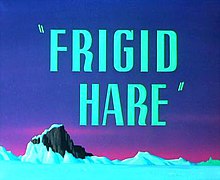Frigid Hare
| Frigid Hare | |
|---|---|
 The title card of Frigid Hare. | |
| Directed by | Charles M. Jones |
| Produced by | Edward Selzer (uncredited) |
| Animation by | Phil Monroe Ben Washam Lloyd Vaughan Ken Harris |
| Layouts by | Robert Gribbroek |
| Backgrounds by | Peter Alvarado |
| Color process | Technicolor |
Production company | |
| Distributed by | Warner Bros. Pictures The Vitaphone Corporation |
Running time | 7 minutes |
Frigid Hare is a 1948 Warner Bros. Merrie Melodies short, released in 1949, and was directed by Chuck Jones and written by Michael Maltese.[1] The title can be seen as a simple play on "frigid air" and/or on the refrigerator brand called "Frigidaire".
Synopsis
While traveling to Miami Beach for an overdue vacation from Warner Brothers, Bugs Bunny mistakenly ends up at the South Pole, having yet again missed the left turn at Albuquerque. While there, he meets a young penguin being pursued by an Eskimo hunter. Bugs sends the hunter in the opposite direction but finds the penguin has grown attached to him. Wanting to get back to his vacation, Bugs distracts the penguin, then pushes him down a snowbank, only to see him land in the hunter's bag. Bugs starts to resume his journey but is overcome by his better nature ("Oh, always somethin'! I'll never get to Miami!") and rescues the penguin. Although successful, Bugs grumbles that he only has four days of vacation left, only to learn from the penguin that, at the South Pole, the days are six months long. Figuring this means he can stretch his four-day vacation until July 1953, Bugs dons top hat and tails and accompanies the penguin on "a nice long formal vacation."
Edited versions
- On the syndicated Merrie Melodies Show, Bugs calling the Inuit hunter an "Eskimo pie-head" was muted out, though not Bugs' calling him a "dope" just before the offending line.
- This cartoon was initially banned from airing on the 2001 installment of Cartoon Network's "June Bugs" marathon due to the stereotypical portrayal of the Inuit hunter. The cartoon resurfaced on a February 2002 airing of The Looney Tunes Show on Cartoon Network (in an installment that showed only Chuck Jones cartoons due to the director's then-recent death), with only one edit: After Bugs finds out from the penguin that the days and nights are six months long in the Antarctic, Bugs' line about not having to return to work until July 1953 is edited (either due to time reasons or to keep the cartoon from showing its age, though most other cartoons that have dated references in them haven't been edited for this reason). When the cartoon aired again on a 2002 "June Bugs", wherein all the Bugs Bunny cartoons that Cartoon Network is allowed to air are shown in alphabetical order, both the 1953 line that was cut when CN first showed this cartoon and the "Eskimo pie-head" line that was muted from the syndicated Merrie Melodies Show were edited out of the new CN version. This cartoon aired again in 2011, with the same edit it had nine years ago, and has aired (with the same parts cut) in 2014 and 2015.
- On a 1965 telecast of The Bugs Bunny Show, Bugs' line about not going back to work until July 1953 was changed to July of 1968.
Availability
- Frigid Hare is available, uncut and restored, on the third disc of Looney Tunes Golden Collection: Volume 1 (2003).
References
- ^ Template:Bcdb title bcdb.com May 9, 2011
